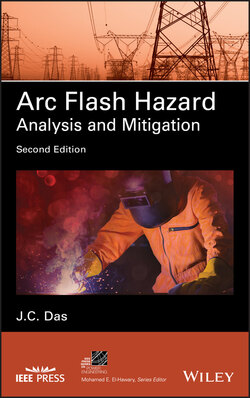Читать книгу Arc Flash Hazard Analysis and Mitigation - J. C. Das - Страница 23
1.6 ELECTRICAL SHOCK HAZARD
ОглавлениеOne of the most complete analyses of occupational electrical injuries in the United States are two papers by Jim Cawley [37, 38]. On an average, one person is electrocuted in work places every day in United States. There are a number of ways the exposure to shock hazard occurs. The resistance of the contact point, the insulation of the ground under the feet, flow of current path through the body, the body weight, the system voltage, and frequency are all important. A dangerous consequence is a heart condition, known as ventricular fibrillation, resulting in immediate arrest of blood circulation. Currents as small as a few milliamperes through the heart can cause disruption of electrical signals that the heart uses to perform its functions. Voltages as low as 50 V can cause fibrillation and can result in death.
The following synopsis of tolerable currents is from IEEE Standard 80, Guide for Safety in AC Substation Grounding [21]:
At 50 or 60 Hz, a current of 0.1 A can be lethal. The human body can tolerate slightly higher 25 HZ current and five times the DC current. At frequencies of 3000–10,000, even higher currents are tolerated. The most common physiological effect, stated in terms of increasing current, are: threshold of perception, muscular contraction, unconsciousness, fibrillation of heart, respiratory nerve blockage and burning [22], and IEC 604791 [23].
The perception level is 1 mA. Currents in the range of 9–25 A may be painful and may make it difficult or impossible to release energized objects. In the range 60–100 mA, ventricular fibrillation, stoppage of heart, or inhibition of respiration might occur, causing injury or death. As shown by Dalziel and others [24], the nonfibrillating current of magnitude IB at durations ranging from 0.03 to 3.0 seconds is related to energy absorbed by the body, given by:
(1.2)
where ts is the time duration of the current in seconds, and SB is an empirical constant related to the energy through the body. Thus, reducing the arc flash incident energy through fast fault clearance times also reduces SB.
Based upon the Dalziel and Lees’ studies [25], it is assumed that 99.5% of all persons can safely withstand, without ventricular fibrillation, the passage of current IB, given by:
(1.3)
Dalziel found that SB = 0.0135 for a body weight of 110 lbs (50 kg). Then:
(1.4)
This gives 116 mA for 1 second and 367 mA for 0.1 second. For 70 kg weight, SB = 0.0246 and k = 0.157. These values are adopted in IEEE Guide 80 [21]. Fibrillation current is assumed to be the function of body weight (Figure 1.6).
Other researchers have suggested different values of IB. In 1936, Fwerris et al. [26] suggested 100 mA as fibrillation threshold; this value was derived by extensive experimentation at Columbia University. Some more recent experiments suggest the existence of two thresholds: one for shock duration less than one heartbeat period, and the other for the current duration longer than one heartbeat period. For a /50 kg body weight, Biegelmeier [27] proposed threshold levels of 500 and 50 mA, respectively. Other studies were carried out by Lee and Kouwenhoven [28]. Figure 1.7 shows a comparison of Equation (1.4) and Z-shaped body current time developed by Biegelmeier.
Figure 1.6. Fibrillating current (ma) rms, versus body weight. Source: Reference [21].
